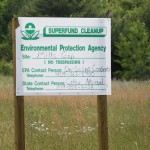- Out in the open: Mills Gap Road residents outside the abandoned CTS of Asheville plant in a 2010 vigil protesting contamination. In the wake of a WLOS report, they’re renewing their push for accountability and a full cleanup File photo.
The Skyland Fire Department’s white-walled community room might not be the usual place to watch an in-depth news report, but for the roughly 50 people gathered late on the afternoon of Nov. 18, it wasn't a typical viewing.
Many residents of the Mills Gap Road area have lived with the specter of severe health risks for more than a decade. Trichloroethylene, a carcinogen, leaked into the groundwater under the abandoned former CTS of Asheville electroplating plant, and for years some residents drank, cooked and bathed in contaminated water from their wells. Watching this particular report, many of them displayed visible emotion.
Over the years, locals and environmental activists alike have repeatedly decried what they see as governmental negligence, lack of transparency and failure to tackle a major health hazard. Some have even alleged that U.S. Environmental Protection Agency officials knew about the contamination, failed to act on it or inform the public, and subsequently tried to cover their tracks. Local media (including Xpress, which broke the story in 2007) have periodically reported on the issue. But while the EPA did add the site to its Superfund list in 2012, a full cleanup remains years away.
Now, however, WLOS reporter Mike Mason and colleagues at the station have spent six months putting together “Buried Secrets,” an hour-and-15-minute report that details how trichloroethylene leaked through a concrete holding tank in the abandoned plant and eventually into the groundwater below. The report includes interviews with U.S. Rep. Mark Meadows, UNC Asheville professor Jeff Wilcox, local activist Tate MacQueen and a former CTS manager, among many others.
“Buried Secrets” also touches on the 63,000 pages of documents the station acquired through a federal Freedom of Information Act request, revealing that some EPA officials knew about the contamination as far back as 1990 — long before the agency informed neighboring residents. In the report, Mason sharply questions EPA staff about negligence and raises concerns about missing records.
“They [the EPA] have dragged this thing on for so long,” Mason told the residents after the viewing. “We wanted to create something undeniable. … What bothers me is, they knew and they knew and they knew — and now it's in the groundwater.”
Community unites
In a July interview that’s included in the report, Meadows criticized the EPA and said he'll seek congressional hearings on the issue. Mason, meanwhile, said he'll keep pressing Meadows.
“My job is to hold him accountable, to say, 'You saw this, now what are you going to do about it?'”
Mills Gap residents hope the report will add vigor to a renewed push for a cleanup. They applauded during the commercial breaks, and one woman exclaimed that Mason should take “Buried Secrets” “to the president's desk.” Meanwhile, they raised questions about possible additional sources of contamination and when the long-awaited hookup to municipal water would arrive. Mason, however, said that despite his in-depth report, the issue is so complex that there are still plenty of other aspects to investigate.
“The time for the games we've been enduring is over," MacQueen said after the viewing, calling for a full cleanup of the site and a “cleanout of the officials who did this,” including an FBI investigation and congressional hearings.
But even residents who've faced many of the same dangers haven't always agreed on how to respond to them. Issues such as financial settlements, media attention and the best way to deal with CTS and the various government agencies involved have sometimes proved divisive.
In 2005, the Rice family, one of the ones most affected by the contamination, agreed to a settlement with CTS. In the WLOS report, however, Dot Rice says that if she’d known some of the things that started coming to light in 2007, she wouldn’t have agreed to the settlement, which limited future legal action against the company (see sidebar, “Legal Battles Continue”).
MacQueen, meanwhile, admitted that these divisions have sometimes led to a community “as fractured as the bedrock” underneath the abandoned plant. “That's something we should all be working toward healing,” he said. “Sometimes I think, when situations are raw like this, it can cause people to work themselves away from who they are, and I'm just as guilty as the next person.”
Nonetheless, MacQueen continued, the community is now united behind the push for the state and federal governments to finally deal with the contamination, firmly believing that the issue is significant not only for locals but for people across the country.
“If you think this is the only community that's been treated like this,” he observed, “then everything we've worked for is a loss.”
For more stories about the CTS contamination, go to mountainx.com/cts. To view a timeline of the CTS case, go to timetoast.com/timelines/cts-contamination. For more of the history, visit mountainx.com/xpressfiles/040908ctssite.






Before you comment
The comments section is here to provide a platform for civil dialogue on the issues we face together as a local community. Xpress is committed to offering this platform for all voices, but when the tone of the discussion gets nasty or strays off topic, we believe many people choose not to participate. Xpress editors are determined to moderate comments to ensure a constructive interchange is maintained. All comments judged not to be in keeping with the spirit of civil discourse will be removed and repeat violators will be banned. See here for our terms of service. Thank you for being part of this effort to promote respectful discussion.